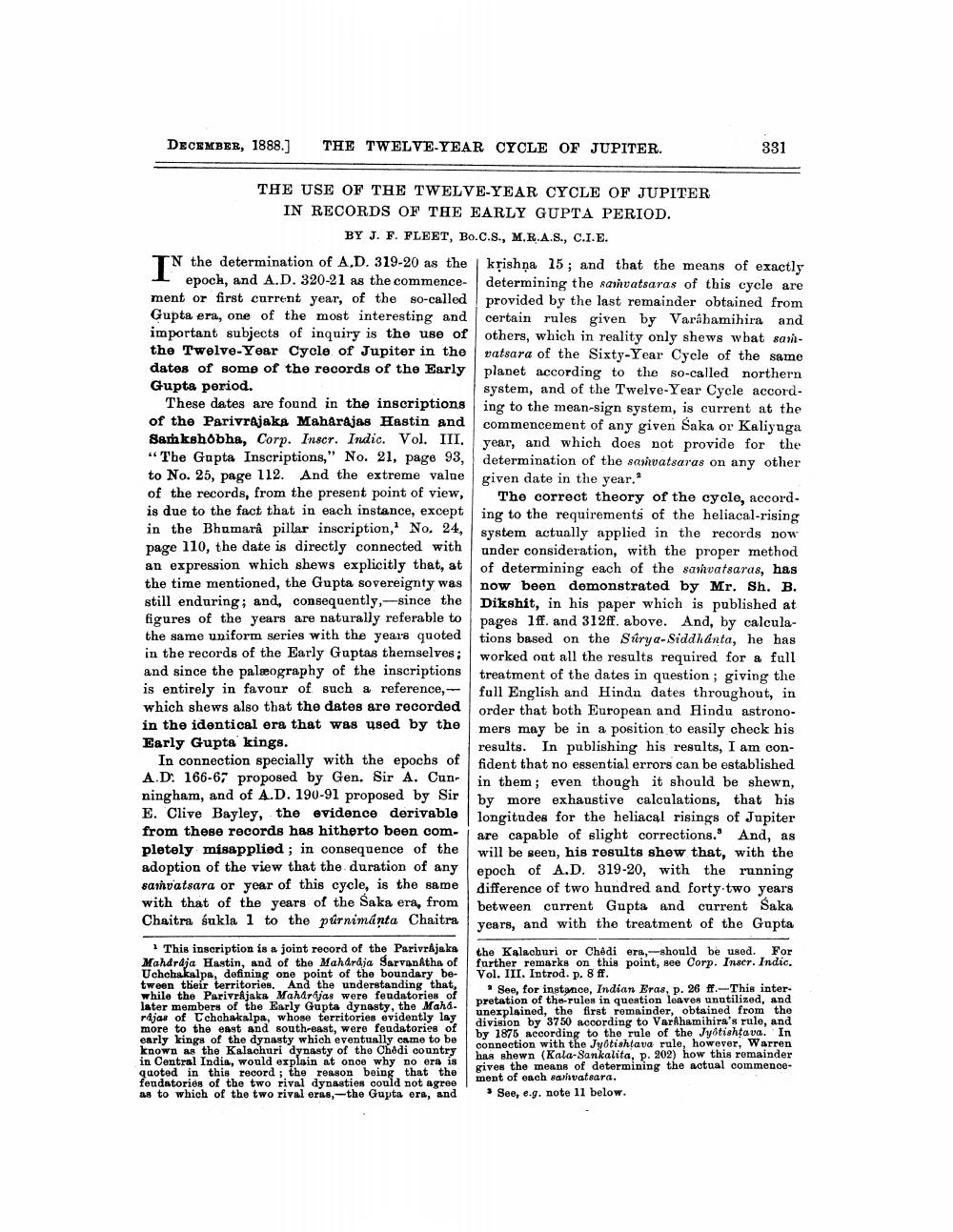________________
DECEMBER, 1888.)
THE TWELVE-YEAR CYCLE OF JUPITER.
331
THE USE OF THE TWELVE-YEAR CYCLE OF JUPITER IN RECORDS OF THE EARLY GUPTA PERIOD.
BY J. F. FLEET, Bo.C.S., M.R.A.S., C.I.E. TN the determination of A.D. 319-20 as the krishna 15; and that the means of exactly
1 epoch, and A.D. 320-21 as the commence- determining the samvatsaras of this cycle are ment or first current year, of the so-called provided by the last remainder obtained from Gupta era, one of the most interesting and certain rules given by Varihamihira and important subjects of inquiry is the use of others, which in reality only shews what santhe Twelve-Year Cycle of Jupiter in the ratsara of the Sixty-Year Cycle of the same dates of some of the records of the Early planet according to the so-called northern Gupta period.
system, and of the Twelve-Year Cycle accordThese dates are found in the inscriptions ing to the mean-sign system, is current at the of the Parivrajaka Maharajas Hastin and
commencement of any given Saka or Kaliyuga Samkshobha, Corp. Inscr. Indic. Vol. III. year, and which does not provide for the "The Gupta Inscriptions," No. 21, page 93, determination of the samvatsaras on any other to No. 25, page 112. And the extreme value given date in the year. of the records, from the present point of view, The correct theory of the cycle, accordis due to the fact that in each instance, except ing to the requirements of the heliacal-rising in the Bhumara pillar inscription, No. 24,
system actually applied in the records now page 110, the date is directly connected with
under consideration, with the proper method an expression which shews explicitly that, at of determining each of the sarhvatsaras, has the time mentioned, the Gupta sovereignty was now been demonstrated by Mr. Sh. B. still enduring; and, consequently,--since the Dikshit, in his paper which is published at figures of the years are naturally referable to pages lff. and 312ff. above. And, by calculathe same uniform series with the years quoted tions based on the Súrya-Siddhanta, he has in the records of the Early Guptas themselves; worked out all the results required for a full and since the palæography of the inscriptions
treatment of the dates in question ; giving the is entirely in favour of such a reference,
full English and Hindu dates throughout, in which shews also that the dates are recorded order that both European and Hindu astronoin the identical era that was used by the mers may be in a position to easily check his Early Gupta kings.
results. In publishing his results, I am conIn connection specially with the epochs of
fident that no essential errors can be established A.D. 166-67 proposed by Gen. Sir A. Cun
in them; even though it should be shewn, ningham, and of A.D. 190-91 proposed by Sir
by more exhaustive calculations, that his E. Clive Bayley, the evidence derivable
vidence derivable longitudes for the heliacal risings of Jupiter from these records has hitherto been com
are capable of slight corrections. And, as pletely misapplied ; in consequence of the will be seen, his results show that, with the adoption of the view that the duration of any epoch of A.D. 319-20, with the running sarhvatsara or year of this cycle, is the same
difference of two hundred and forty-two years with that of the years of the Saka era, from
between current Gupta and current Saka Chaitra sukla 1 to the purnimanta Chaitra
years, and with the treatment of the Gupta This inscription is a joint record of the Parivr&jaka
the Kalacburi or Chedi era,should be used. For Mahdrdja Hastin, and of the Mahardja SarvanAtha of further remarks on this point, see Corp. Inser. Indic. Uchchakalpa, defining one point of the boundary be- Vol. III. Introd. p. 8 ff. tween their territories. And the understanding that,
* See, for instance, Indian Eras, p. 26 ff.-This interwhile the Parivr&jaka Maharajas were feudatories of
pretation of the rules in question loaves unutilized, and later members of the Early Gupta dynasty, the Maha.
unexplained, the first remainder, obtained from the rdjas of chohakalpa, whose territories evidently lay
division by 3750 woording to Varhamihira's rule, and more to the east and south-east, were feudatories of
by 1875 according to the rule of the Jyotishtava. In early kings of the dynasty which eventually came to be
connection with the Jyotishtava rule, however, Warren known as the Kalachuri dynasty of the Chedi country
has shown (Kala-Sankalita, p. 202) how this remainder in Central India, would explain at once why no era is
gives the means of determining the actual commencequoted in this record; the reason being that the
ment of each sarhvatsara. feudatories of the two rival dynasties could not agroo as to which of the two rival eras,-the Gupta era, and See, e.g. note 11 below.




